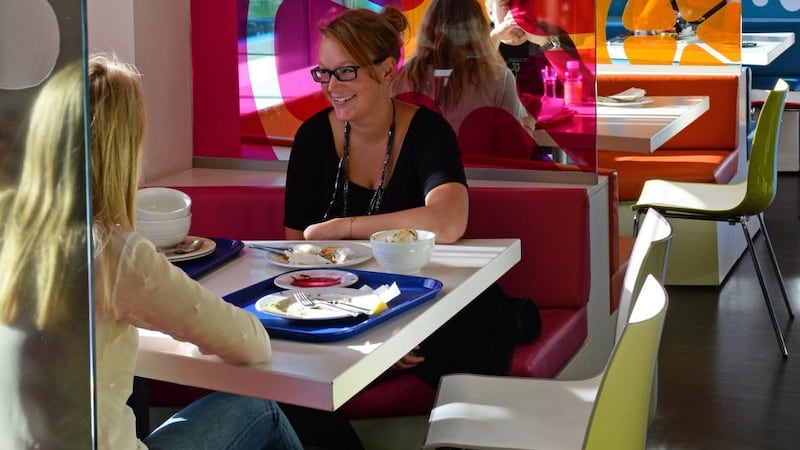The box hedge is trembling in its cartoon-coloured pots in a stiff north wind outside Google's European headquarters in Barrow Street in Dublin, but the Googlers (sorry, but everyone here calls them that, like they're Oompa Loompas) walk out without coats. Some of them are in T-shirts. Either these bright sparks have a different core temperature or they're crossing to another warm building here at the heart of Google city.
At offices all over the country, workers are wrapping up to go out and buy a lunch that they will bring back and eat at their desks. Workplace lunches are a huge business. Cafes, sandwich shops and restaurants grow at the feet of office blocks like mushrooms under oaks – but not here. No one brings their food into this building. It would be carting coals to Newcastle.
I’m here to taste what Googlers eat, that famously free breakfast, lunch, dinner and an all-day all-you-can-eat buffet of snacks that’s a perk of the job. The company laminate clipped to the waistband of your jeans is a set of keys to the sweetshop, the fast track for some to the Google stone gained in the first few months.


The PR consultant who’s bringing me into the building says they have shifted things since the term was first coined. They put the high-calorie sweets at the bottom of the racks and are adding more fresh vegetables, fruit salads and diet drinks into the snack mix. “You can be as healthy or as unhealthy as you like,” she says. So a bit like life, then.
Here they colour code snacks with the traffic light colours: red for bad, amber for okay and green for good. Then it’s up to the Googler to decide between a Wispa bar and a plate of carrot sticks.
Tempting as it is to neck 10 bags of Skittles and see how long it takes to get the sugar jitters, we’re going for a sit-down lunch in the restaurant instead.
There are three restaurants across across the Google buildings and "micro-kitchens" on every floor with limitless drinks and snacks. They are all run by a young husband-and-wife team, Brian and Elena Begley.
Brian spent four years working in catering in Germany before setting up a small company in 2000 making sandwiches in an enterprise centre in Terenure. In 2004, the company was making one sandwich delivery a week to Google. As the internet giant grew, so did they. Now they feed an average of 2,500 Googlers a day and employ 85 people. In 2005, Brian went to Google US headquarters at Mountainview, California to see how they catered for staff there.
The Irish offering is based on some of what he saw there, but it’s not a McDonald’s model of homogeneity.
These days, Googlers make their own sandwiches at the deli counter if they don’t want to go to the restaurant, choosing wraps, rolls or bread, then filling them with ingredients before toasting their creation in a photocopier-sized panini toaster. The biggest buzz though is in the restaurant, which is a like a college canteen in an extremely well-heeled American campus.
Instead of the communal dining hall, it’s full of colourful cave-like spaces where people can sit in groups to eat. There are some padded cocoon chairs for the Greta Garbo option of dining with laptop or phone. Given where we are, it’s a surprise not to see anyone gazing at a screen while they queue.
People talk to each other or check out the food they’re going to put on their red plastic trays.
Brian Begley says they source as many ingredients as they can in Ireland. All their meat is Irish. Vegetables come from north Dublin grower Keelings and fish is sustainably sourced. Plenty of diners are opting for the broccoli and red cabbage today.
I join the queue for today’s Pakistani dishes and get some nan bread, fennel-seeded rice and a portion of lamb curry. Most impressive are the fresh herbs grown in pots as if for decoration. There’s a scissors alongside though so you can snip a fresh garnish for your lunch, like the green coriander I put on my curry.
Then there’s beetroot and spinach salad (I’m thinking in colours for the photographer here, which isn’t a half bad way to choose your food). Next, an idea I really like: you can make your own soup. There’s a hot soup stock, it’s broccoli and celery today. It sits alongside a salad bar of fresh ingredients so you can take a broth base and drop ingredients in. My haricot beans, sweetcorn, finely chopped leeks and dill works. Finally I get a glass of flavoured water, pineapple and ginger with whole green chillies floating in it too.
Lunch is delicious. The lamb is as good as any home cook would make from scratch with a special trip to an Asian market for fresh spices. There are spanking fresh salads with buckets of flavour. In the line of duty, I try some of the strawberry and clotted cream cake for dessert, with a mug of great coffee. There are ice cream cones with sprinkles, but it’s November.
We are joined for lunch by facilities manager Trevor Smyth. He shows no evidence of a Google stone, possibly because he only sits down at lunch and at meetings. The rest of the time he works at a standing desk.
You can see the corporate logic behind free food. No one leaves the building to nip to a sandwich shop. Employees don’t have to think about what to pack for lunch, plan for dinner or buy in for breakfast. Google is one big patient Mammy doing it all for them, leaving them more time to work.
Is Brian Begley deskilling a generation by feeding them so comprehensively everyday? “We’re giving people options,” he says. They hold cookery classes, team events and competition to give the employees cooking skills. Lots of Googlers like to cook for their friends at weekends, apparently. Barista training is also offered.
What is the most popular dish in the Google restaurants? Generally it’s the dishes that don’t appear very often, he says
As we leave to go back into the world where there's no such thing as a free lunch. someone has written "cod plus one" on the feedback whiteboard. It sounds like an order, but it's a compliment to the chef. In Googlespeak.
How other workers eat
THE FISHERMAN: Frank Fleming, founder of the Responsible Irish Fishing label
Typical lunch: Hake grilled with butter, potato wedges, tinned peas or beans
Tradition had it that the last man on cooked the meals on an Irish fishing trawler. When a new crew member joined that cook moved up a rung and off cooking duties leaving it to the newest, and usually youngest, crew member. It didn't make for brilliant dining onboard, according to fisherman Frank Fleming.
He’s the cook now on his trawler which fishes from Schull in west Cork. There are two key factors in what’s for lunch on a trawler. The first is weather. Choppy seas mean everything has to be done in an oven so pots don’t slide off the hob. The second factor is how busy everyone is. If the fishing is good and everyone’s up top, then lunch is usually a thrown-together affair.
Cooking is really only done on bigger boats that fish for three or more days at a time. On day boats, fishermen usually bring sandwiches. “On a lot of boats they’d eat part of what they catch themselves. A lot of days you’d eat fish. It’s so easy to cook and you’re spoilt for choice because you’re eating it straight out of the sea. When we see fish in the shops it doesn’t look the same.”
Older fishermen tend to be more health-conscious than the younger ones, he says. “A burger is fine for those lads but as they get older they get a bit wiser.”
Lots of younger fishermen get ulcers from a bad diet. Long and busy hours, often in the night, lead to snacking and plenty of treats. "It's the kind of lifestyle that does lead to poor discipline in eating."
THE TEACHER: Joe Lyons, principal, Ballybrown National School, Limerick
Typical lunch: ham, cheese and tomato sandwich on Kearney's bread
One big change during Joe Lyons's 30- year career as a teacher is the healthy habits of teachers. "Of our staff of 20 adults, no more than five drink tea or coffee. It's almost all water in the staff room."
His diet is “probably typical of middle- aged men, who are creatures of habits. Female teachers, and the vast majority of teachers are female, tend to go for soups in winter and salads in summer.” They have, he says, “more imagination” when it comes to eating. Joe’s “unadventurous” lunch consists of a sandwich he makes at 6.45am before coming to school. It’s made with ham, cheese and tomato on a honey and spelt bread he gets from Kearney’s Bakery in Limerick. A teacher’s lunch is not a leisurely one, he says, “but it’s really important for people to unwind and have adult conversation, laughing about what you did at the weekend.”
The school, with 270 pupils, is in a ribbon development on the outskirts of Limerick, with the intake almost doubling in recent years. The children’s lunches are almost all water, fruit and a sandwich, he says. A healthy eating policy was introduced. “It’s an area most schools take very seriously and parents have taken it on board.”
Parents of junior infants are encouraged to give their children something small and easy to eat in the fruit department, rather than a single large apple. And how do they encourage children not to bring home the fruit uneaten at the end of the day? "At 10am we ring a bell for fruit break and everyone has three minutes to eat their fruit."
THE CHEF: Jess Murphy, chef, Kai
Restaurant, Galway
Typical lunch: Local cheeses, Stephen Gould's leaves, homemade brown bread
"At the moment I'm living off tacos," Jess Murphy jokes in answer to the question of what chefs eat for lunch. Actually, she's having venison hot pot today. "We have whatever's left over from lunch."
In the absence of leftovers, a typical lunch is local cheese and greens, brown bread and a staff soup. “The lads are going on to work the night service and you can’t give them a cheese and ham toastie.”
What about the diet pitfalls of that demanding shift work? “The chefs and I made a pact ages ago not to drink fizzy drinks,” she says. Having had her team in place for two years, Murphy believes they have learned how to eat properly. The morning starts with a shake. The king ingredient at the moment is the feijoa, a New Zealand fruit that Murphy remembers picking in armfuls as a child. A guava-like fruit, it goes into the blender with organic apple and orange juice, bananas and some powdered spirulina, seaweed or wheatgrass.
“At the end of the night we might have a salad. You’d save all the beef trimmings or duck and have it to finish. It’s usually 10.30pm so we try not to give everyone a carb overload before they go to bed.”


















